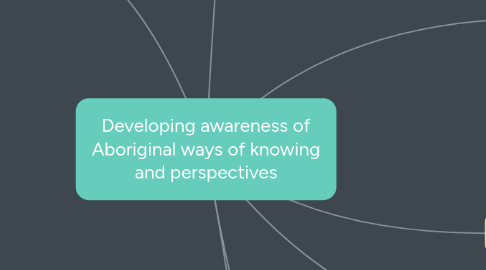Developing awareness of Aboriginal ways of knowing and perspectives
by Joe S


1. What we can do in our teaching practices?
1.1. Move towards a child-centred teaching practice
1.1.1. This was what the educational model was like prior to Aboriginal peoples contact with European settlers
1.2. Focus on all aspects of the child. which includes: mental, physical, emotional, and spiritual
1.3. Teach through the circle of courage model
1.3.1. Recognize the four stages that children go through: belonging, mastery, independence, and generosity
1.4. Teach through games; this was one way in which skills and knowledge were acquired
1.5. Prepare children for their lives by teaching relevant material
1.6. Encourage students to accomplish taks for the sake of completing the goal. The reward should be intrinsic
1.6.1. Thus, make it interesting and relevant to the students' lives
1.7. Provide opportunities for students to physically manipulate, see or hear about the concepts that they are learning first-hand
1.8. Learning should occur outside of the classroom
1.9. Involve family and community members
2. Learning outcomes for Geography at the secondary level by including Aboriginal perspectives (just a few):
2.1. Demonstrate an understanding of the importance of respect in Aboriginal cultures
2.2. Demonstrate the traditional family structure of Aboriginal peoples
2.3. Identify communities that reclaimed their traditional names
2.4. Identify factors that have contributed to changes in the structure of Aboriginal families
2.5. Demonstrate awareness of the importance of family and community in the identity of many Aboriginal peoples
2.6. List the natural resources that were important to Aboriginal groups prior to European contact
2.7. Demonstrate understanding of diseases introduced by Europeans
2.8. Compare the perception of the land held traditionally by Aboriginal peoples and European peoples
2.9. Describe the differences in perception of land. wealth, and ownership affected the interaction of Aboriginal and European peoples in the past
3. Aboriginals in Canada
3.1. First Nations
3.2. Métis
3.3. Inuit
4. Issues:
4.1. Canada has often ignored the contributions that have been made and continue to be made by Aboriginals
4.2. Aboriginal perspectives have been missing in curriculum documents
5. Why include Aboriginal perspectives?
5.1. The inclusion of Aboriginal perspectives will benefit not only Aboriginal peoples, but non-Aboriginals too.
5.2. All people are denied a quality educaiton if they are not exposed to the contributions made by all people in the development of the country in which they live
5.3. To benefit Aboriginal students, such as to have them:
5.3.1. Develop a positive self-identity
5.3.2. Equip them with the knowledge and skills to participate in their own communities
5.3.3. Improve academic performance
5.3.4. increase the representation of Aboriginal peoples in post-secondary schools
